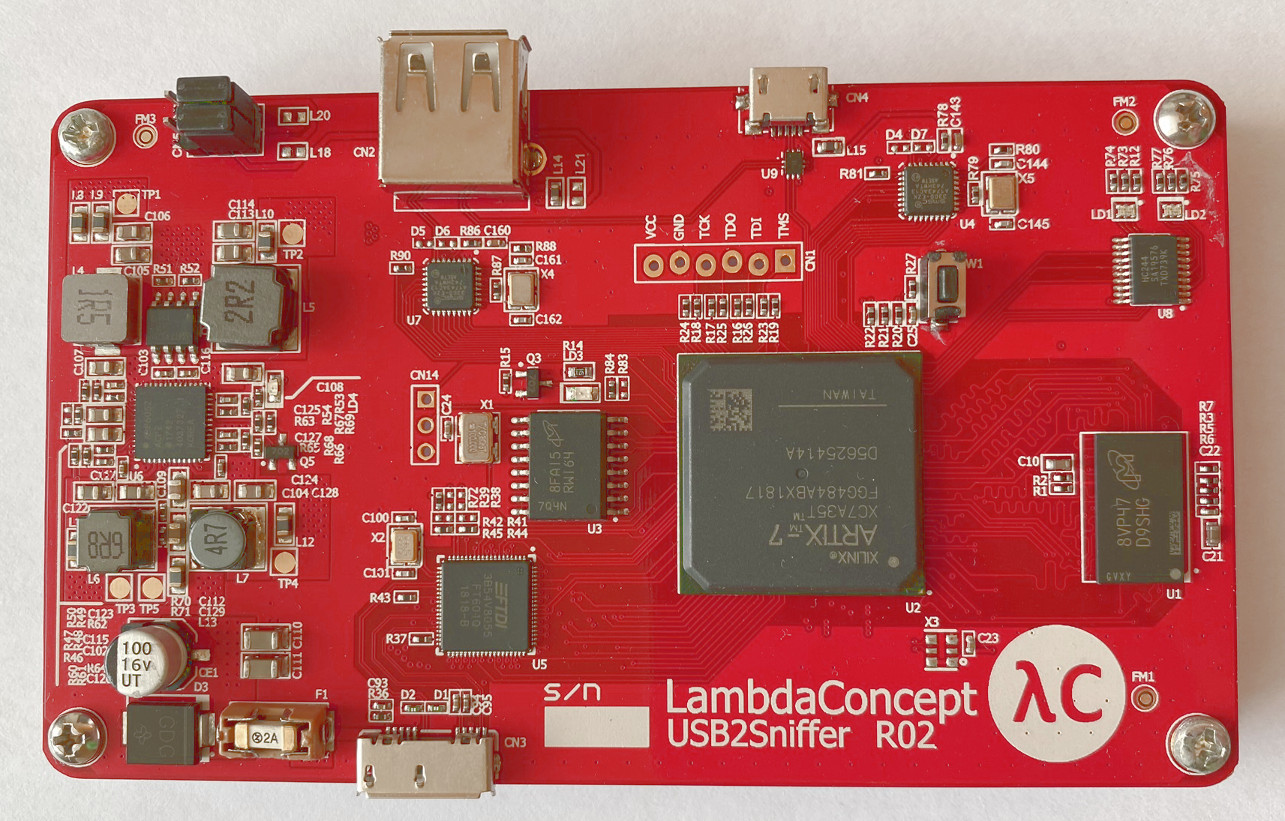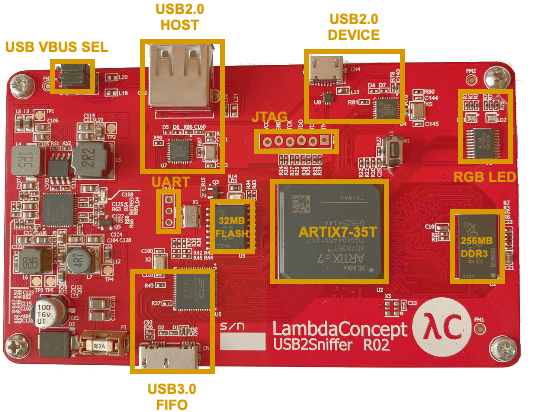Github: https://github.com/ultraembedded/riscv_sbc
This repo contains a working RISC-V based Single Board Computer project based around the LambaConcept USB2Sniffer FPGA board.

The board is available for purchase on the LambdaConcept shop;
https://shop.lambdaconcept.com/home/35-usb2-sniffer.html
The USB2Sniffer is designed to be used as a USB 2.0 capture device, or as a development board for USB 2.0 IP designs.
It has plenty of fast DDR3 RAM and SPI-Flash, as well as USB 2.0 (Host + Device) and USB 3.0 (high speed FIFO) interfaces.
It can be repurposed as a single board computer (SBC) for running RISC-V Linux with both USB 2.0 host and USB 2.0 device support!
- XC7A35T Artix 7 Series FPGA xc7a35t-fgg484-1
- 256MB DDR3 Micron MT41K256M16TW-107
- 32MB SPI Flash Micron MT25QL256ABA
- USB3.0 to FIFO Bridge (up to 400MB/s of bandwidth to the FPGA) FTDI FT601
- 2 x High Speed USB2.0 ULPI PHY Microchip USB3300
- 3 RGB LEDs, 2 x GPIO pins
To clone this project and its dependencies;
git clone --recursive https://github.com/ultraembedded/riscv_sbc.git
Most of the IP cores used in this project are designed by myself and available as easy to follow open-source Verilog modules. The remainder (DDR3, CDC, PLL) are IP cores built with Xilinx Vivado.
| Name | Description | Provider |
|---|---|---|
| riscv_top | 32-bit RISC-V CPU or Dual Issue RV32 | - |
| usb_host | Basic USB Host | - |
| ulpi_wrapper | ULPI PHY Interface | - |
| core_soc | Peripherals - UART, SPI, GPIO | - |
| dbg_bridge | UART to AXI bus master | - |
| spiflash | SPI-Flash XIP | - |
| usb_serial | USB Device UART | - |
| mig_axis.xci | MIG DDR3 Controller | Xilinx |
| axi_cdc_buffer.xci | AXI4 Clock Domain Converter | Xilinx |
| axilite_cdc_buffer.xci | AXI4-Lite Clock Domain Converter | Xilinx |
- DDR3, SPI-Flash, ULPI interfaces now working.
- RISC-V CPU booting Linux RV32 5.0 kernel to BusyBox userspace.
- Option of USB Serial port implemented in the FPGA fabric for Linux console access (connected via USB micro port).
- Option of Linux console / debug output via UART connector (@ 1M baud).
- USB Host port working under Linux (mounting USB storage devices).
- Initial Verilog source released.
- Prebuilt bitstream added to 'bitstreams' folder.
- More instructions to come...
A prebuilt FPGA bitstream and series of bootloaders are provided in the bitstreams directory.
These can be flashed onto the board with a Vivado supported programmer using the provided makefile / Vivado TCL;
# Make sure vivado tools are available in the shell path....
# Create a MCS file containing the bitstream and various bootloaders
# This creates riscv_sbc.mcs
cd bitstreams
make create_mcs
# Program riscv_sbc.mcs onto the onboard SPI-Flash
make program_flash
The SPI-Flash device is expected to contain the following files;
| Offset | File | Description |
|---|---|---|
| 0x00000000 | fpga.bit | FPGA bitstream. |
| 0x00300000 | primary_boot.bin | Bootloader copies Flash 0x00400000 - 0x0040FFFF to 0x80000000 and jumps to it. |
| 0x00400000 | secondary_boot.bin | Bootloader for Linux. Copies Kernel from FLASH to RAM. |
| 0x00500000 | config.dtb | Linux Device Tree Blob (output from dtc). |
| 0x00600000 | vmlinux.bin | Linux Kernel binary. |
